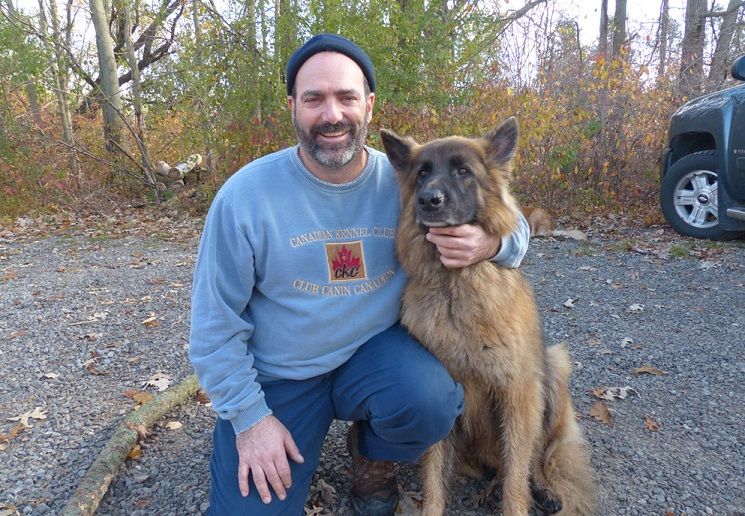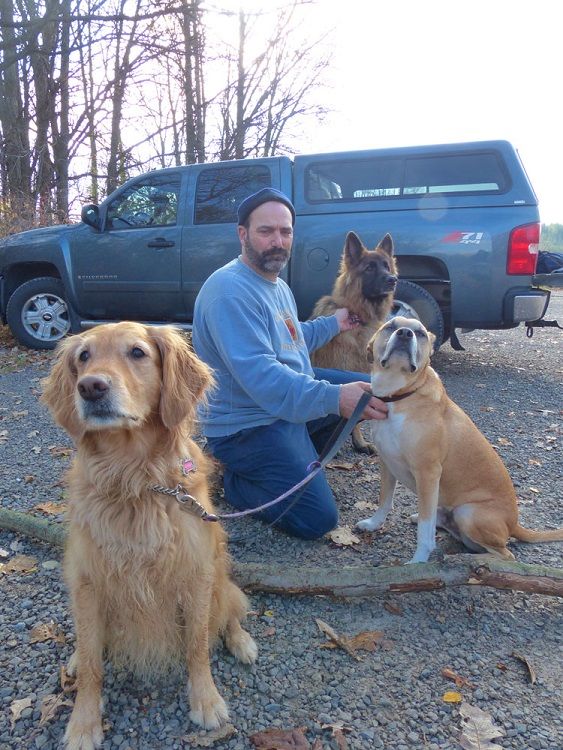How much do you talk to your dog on an average walk?
Do you know the actual number?
A little while ago, one of the people I hike with, Martin, posted on Instagram that he was using a counter (like what bouncers use for crowd control) to track how many times he spoke to his dog, Berrin, during their walks.
We all know that dogs communicate through body language. Martin wanted to see what happened if he tried to speak more dog and less human.
“By not talking, it actually worked better to get my dog to check in with me more,” he said. “Berrin seemed to be paying closer attention to me.”
Have you ever tried not talking to your dog?
Our hike group came about through our trainer, and one of the exercises she has all of her students do early in our classes is not talking to our dogs for a week.
The exercise is not about being mean to our dogs. It is about attention.

Help our dogs learn to pay attention to us by looking at us. Not by tuning out our voices. And helping us pay attention to our dogs. Watch them. See how they move and react and behave. Learn to speak dog.
It’s been a little while since Martin and Berrin went through the no-talking exercise, so at first Berrin seemed a bit uncertain when Martin wasn’t talking to him on walks.
“It was kind of throwing him off, and it was like he was saying, ‘What’s going on?’ But by not talking, he was actually staying closer to me,” Martin explained.
Martin also experienced his own uncertainty and forced himself to wait before calling out to Berrin or giving him a command.
“Every time I went to say something, I thought twice about it and waited a minute to see what happened. And he would turn and I would know I didn’t have to say anything because I know he’s coming back to me.”
Martin found that over a two-hour hike he was able to talk to Berrin just 20 times.
“The mountain bikes always throw me off,” he said. “In the pack [on one of our group hikes] I could probably do the whole walk without talking.”
Does your dog ever ignore you?
Most of us have experienced our dog ignoring us. Talk too much or repeat commands and our voices become just noise and dogs block us out. Not talking forces our dogs to tune into us in different ways.
When Baxter and I are hiking with our group, if we want to follow a particular trail, we go in that direction and don’t usually call our dogs. Some dogs wait at the fork, waiting to find out which way we’re going. Some may run up another trail a little ways, but once they see we’re not going that way, they catch up.
We’re leading them through body language and the bond we’ve built with them over time.
Body language is a big part of building that connection because then we’re speaking our dog’s language. When Baxter and Berrin greet each other or are hiking together, they don’t whine or bark at each other. Yet, they communicate and understand each other.
For Martin, he wanted to see what would happen if he communicated with Berrin in a different way. Would their training pay off? Was our trainer right that not talking strengthened our bond with our dogs? How would Berrin respond?

“It’s always about doing different stuff and getting the most fun out of my dog,” he said. “I want to have the ultimate connection or bond with Berrin.”
You can follow Martin and Berrin in Instagram at @leashes_grease_and_rocknroll.
Tips for not talking to your dog
1. Start small. Don’t talk to your dog when you first come home. Greet her with rubs or play, but don’t speak. Or maybe don’t speak to your dog at meal time. Put out his food and let him know through body language that he can eat.
2. Not talking on an off-leash hike. Off-leash in the woods you’ll likely feel anxious a few times. Make sure you have a good relationship with your dog and are comfortable hiking before you stop talking.
3. Use a counter. You may be surprised how many times you talk to your dog. A counter can help you keep track.
4. Count everything. A command, a comment, a whistle. These are all ways we communicate to our dogs.
5. Think about commands or behaviour you can teach or reinforce through body language. We have taught stay, come, down, sit, loose leash walking, wait to get out of the car/go through the door all through physical signals.
Have you ever tried not talking to your dog?
Julia Thomson is a regular writer to That Mutt. Visit her blog Home on 129 Acres here.

Pamela
Monday 29th of October 2018
I hope I haven't ruined my Border Collie Pit mix, Bruce. I have what some might consider a talking jones... let me just say I stand corrected and will immediately start communicating with him non verbally. I could tell I was making the poor guy crazy with my endless chatter. Most of that came from my own selfish need to be validated. Oh no, I made Bruce codependent like me... I hope he is able to recover with and forgive me. he is the smartest guy I know and hopefully we can restore some sanity into each other. Thank you for this article, and I am turning over a new leaf today. a quiet, more connected leaf.
Karen
Thursday 12th of April 2018
I still have trouble recognizing my pups body language . And I'm not sure we have a bond I feel like we do but how do you know ? I don't take him on walks YET because he is very strong and pays no attention to me holding the leash thus I feel like no bond there. We needs more no pull training - he does well with my husband on walks . Thoughts ?
Johnice Reid
Tuesday 29th of November 2016
I learned the language of dogs decades ago watching documentaries on Wolves. I grew up with dogs and as an adult...lived with as many as 11 at onetime all house dogs. I make mistakes and because they are dogs they forgive me and we learn more about each other that has been true for me since 1945 and I never work at silence it has developed into an instinctual norm...
There are times when I want to scream something at my dogs especially during the first 3 years of their lives...yet I have found that dogs do not like chaos and respond much better to calm and even please and thank you. :) My friends and their dogs admire the relationship I have with my Hounds and their dogs as well. I believe that valuing the company of an animal is as important as with any human...dogs are just better at bringing out the best of you if you learn their language. That is equal in importance as exercise, good food, and medical care. Sorry for drifting into waxing away from the topic...but not talking is a broad learning experience and it is often difficult to let go of words, with dogs words are not in that equation, the are pack animals who look for and to a leader, not a chatty friend. LOL... makes me laugh just to think of it.
Sandy Weinstein
Friday 18th of November 2016
i hate to say this but my 3 gals are the only ones that i interact with on many days unless i use the phone. i am not a phone person. i talk to my girls a lot as if they were humans. yes my girls do ignore me sometimes, however, they are really good girls. they pay more attention to me when we are out in public. when we go for walks, they are more interested in the smells, lots of deer, etc. they are terriers and sometimes find other things more interesting than listening to mom. i know that after my 1st schnauzer passed away, my mom would still talk to her when she went on her walks. sometimes i will use a clicker, or the spray red can, when they see the can they listen and stop what ever they are doing. i cant help but talk to my girls they are so happy to see me as i am them when i am gone for a few hrs. they want me to hold them, hug them, and kiss them. then they go thru the shopping bags to see if i brought them anything. yes i do ignore them sometimes but only when i am really busy. i live in the country, dont get many visitors, so unless i have company which is rare, or i go out, they are my people that i talk to. i think they would think i was mad at them if i did not talk to them.
Kim
Sunday 8th of April 2018
Hi Sandy! You sound like you treat your babies the same way I do mine! Love, hugs, lots of kisses and some good ol' fashioned conversation! I'd rather talk to my baby than most people!
Julia at Home on 129 Acres
Monday 21st of November 2016
Companionship is a key part of why we have dogs, so I understand where you're coming from.
Seth B
Thursday 17th of November 2016
Julia,
Thank you for writing this article, there is such interesting insight in this article. It definitely made me think. I actually took a 2ish mile walk with my GSD, Scarlett tonight and tried not to speak to her during the duration of the walk, and I like Martin found that she seemed to check in with me for frequently. I still gave her the familiar signals, such as to sit at crosswalks or to lie down when another dog approached. Usually on walks I do tend to babble on, haha, I tend to talk to her for the whole duration. I'm sure tonight she was wildly curious as to why I wasn't speaking to her!
I read a book about tracking once, and the very first paragraph emphasized that tracking is a silent and calm activity for dogs.
It really makes sense though, as they are descended from wolves, and there were no humans around to speak to them in the wild.
Thank you again for this posting! Cheers!
Julia at Home on 129 Acres
Monday 21st of November 2016
Thanks for sharing your experience, Seth. Glad you gave it a try.
martin
Saturday 19th of November 2016
hey Sethb it martin gald to hear you and every one else having some success with this going to sound a bit bias but you have one of best breeds to work with. you guys should try and count how many times you talk to your dog it gives you a reality check .now when you call there name there not tuning you guys out thanks and get out and enjoy your dogs martin&berrin